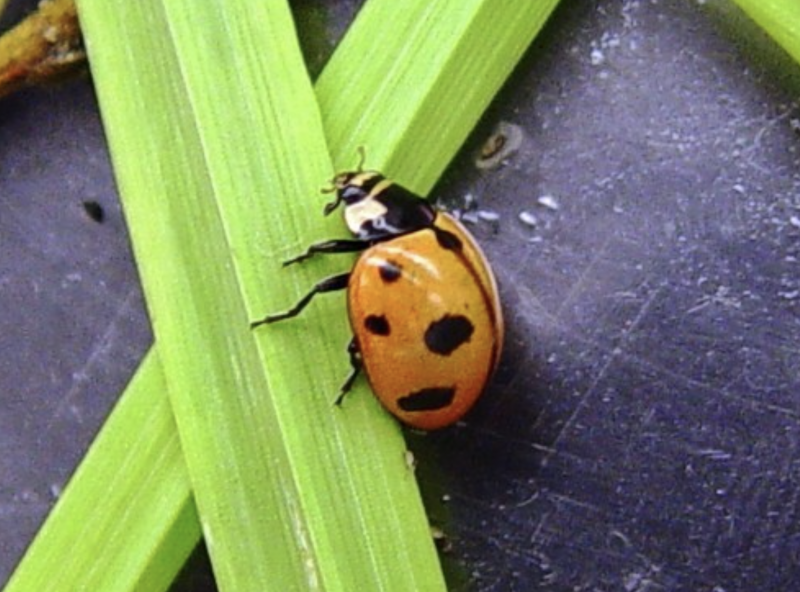This work was conducted by Dr. Louis Hesler, Research Entomologist with the USDA-ARS North Central Agricultural Research Laboratory (NCARL) in Brookings, SD, in collaboration with John Losey (Cornell University), Michael Catangui (formerly South Dakota State University), and Pam Bartlett and Janet Gritzner (SDSU).
Lady beetles are one of the most familiar groups of beneficial insects. Farmers and gardeners appreciate them for devouring insect pests. Both adult lady beetles and caterpillar-like juveniles eat pests.
Lady beetles are recognizable by their red and orange colors that contrast with black spots and bands. But not all have this appearance. Some are dull brown or black and often smaller than the brightly colored ones. Over 600 kinds, or species, of lady beetles are known from the U.S., Canada and Mexico. However, only about a dozen kinds are common in crop fields, orchards and gardens.
While tracking lady beetles in South Dakota crop fields in the 1980s, some of Louis Hesler’s ARS colleagues noticed that a few species had declined in numbers. ARS scientists and other researchers began trying to determine why and how widespread the declines might be.
As scientists like Hesler continued surveying for lady beetles, results confirmed that numbers of certain species had dropped. The declines also seemed widespread. However, there were too few scientists to adequately cover an area as vast as North America. Hesler called for help from others, including Cornell University entomologist John Losey, who planned on enlisting the help of citizen scientists in a program known as the Lost Ladybug Project (LLP).
Lost Ladybug Project

The project began receiving funds from the National Science Foundation in 2008. Since then, project participants have been looking for lady beetles, snapping digital images of them, and uploading images at the Lost Ladybug Project website.
By May 2013, over 4000 participants had produced more than 20,000 useable images of lady beetles. Images have come from all 50 U.S. states, 10 Canadian provinces, and six Mexican states. Images are mapped and stored in the LLP database and available to website visitors.
Participants have made several findings of the so-called lost lady beetles. The findings show that most lost lady beetles are now present in western states, even though these lady beetles were once found throughout the U.S. and Canada.
Nearly 6 of 10 LLP images consist of lady beetles that are not native to North America. About one-third of all images are the multicolored Asian lady beetle, and over one-fifth are the sevenspotted, or C7, lady beetle, a native of Eurasia. Both lady beetles were intentionally released in North America for biological pest control during the 20th century. It’s unclear whether their presence today resulted from those releases. Instead, the beetles might have arrived unintentionally as stowaways on commercial imports.
It is tempting to link the steep rise in non-native lady beetles with declines in native lady beetles. Losey, Hesler and colleagues have indirect evidence for this. They found that ninespotted, or C9, lady beetles collected in recent years were much smaller than museum specimens collected between 1909 and 1972 before C7 showed up or ones that had been bred in captivity. The scientists were also able to produce comparably smaller C9s when they limited the beetles’ food in the laboratory. Their results support the notion that C7 outcompetes C9, but don’t prove how important this may be when both species occur in the same field.
For instance, former SDSU graduate student Pam Bartlett found C7 and C9 lady beetles together in agricultural fields in southwestern South Dakota and northwestern Nebraska. Her findings raise questions about why both C7 and C9 occur in such places but not others in North America.
Future research from lab and field will be linked with citizen science findings to determine what’s happening to native lady beetles. To see a poster showing the 80 kinds of lady beetles known from South Dakota, view the Ladybugs of South Dakota posting from the Lost Ladybug Project.
The Agricultural Research Service is the chief intramural scientific research agency of the U.S. Department of Agriculture. The NCARL in Brookings, the only ARS facility in South Dakota, is one of the nation’s premier agricultural research laboratories. They develop integrated crop and pest management practices that enhance soil fertility and conservation, improve water availability and quality, increase biodiversity, and reduce insect and weed populations.


